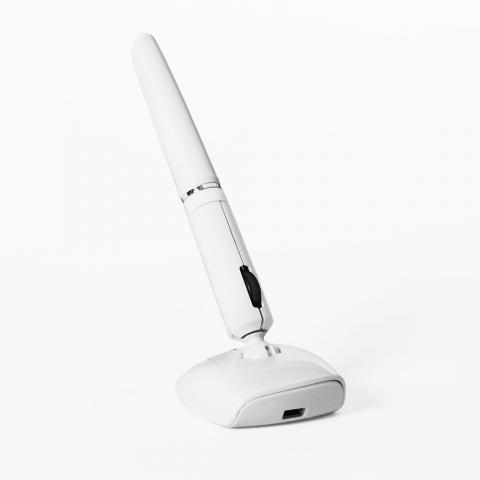If you’re a fan of gadgets designed to fill a very specific niche, and we here at Gadgethead definitely are, then look no further than the Penclic mouse series, computer peripherals designed to look and handle like a pen. Depending on the model, they come with 3 or 5 buttons and connect via USB or Bluetooth. They have a shiny, plastic body in either white or black and a pen-like stem with a matt coat and smooth, rubbery feel. They come in beautiful, tubular transparent packaging and at least the one model we saw included a small cloth bag to carry the mouse in. The B3 that we tested for this review had the standard left button, right button and scroll wheel configuration that you would find on a classic mouse, but they are arranged on the pen to be pressed with your index finger and thumb.
The pen connects to the body of the mouse through a ball joint, allowing you to move your wrist freely, but doing this doesn’t actually alter the position or any actions of the cursor, you’ll still need to slide the mouse across a smooth, non-reflective surface to make it work. It is this wrist position that helps the Penclic define its niche. If you are prone to repetitive strain injury, or just enjoy the feel of holding a pen, using a Penclic mouse will allow you to keep your arm in a more natural position and avoid future aches. You will however have to put in the work to adjust to its button placement. They are, literally, at your fingertips and can be flipped in your OS for right or left-handed use, they respond easily to touch and, overall, feel comfortable. However, the buttons on the Penclic are very different compared to all the other ways we have now to interact with our computers. Between traditional mouse layouts, touch pads, styluses, trackballs and especially, touchscreens, if the Penclic had come out more than a decade ago it would have probably received a much warmer welcome. Now, it’s very specific niche is for RSI-afflicted office workers and the occasional graphic artist. RRP £79.99
4 out of 5
Pros
Natural wrist position
Helps you avoid RSI
Flips between left and right
Good battery life
Cons
Very steep learning curve
- Log in to post comments

